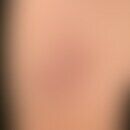Synonym(s)
DefinitionThis section has been translated automatically.
Highly effective halogenated glucocorticoid (class IV), which is mostly used in the form of clobetasol-17-propionate. The optimum stability of clobetasol-17-propionate is at pH 4-6. Hydrolysis of the ester occurs at higher pH values. Therefore, a citrate buffer should be added to all formulations, which consists of equal parts of a 0.5 % citric acid solution and a 0.5 % sodium citrate solution and has a pH value of 4.2. The citrate buffer is used at 5 % of the total formulation. The addition of salicylic acid or urea to clobetasol 17-propionate preparations is controversial.
IndicationThis section has been translated automatically.
You might also be interested in
Dosage and method of useThis section has been translated automatically.
Apply a thin layer of ointment/cream/solution 1-2 times/day to the affected areas of skin.
Please note! Application duration max. 2-3 weeks!
Standard concentrationThis section has been translated automatically.
0.05 % (upper guideline concentration) in ointments, creams and solutions
Undesirable effectsThis section has been translated automatically.
Allergic reactions to clobetasol-17-propionate are very rare. The DKG has previously tested clobetasol-17-propionate 0.25 % in Vaseline. This form of application is no longer available as a test substance in Germany. In this respect, a 1 % concentration of clobetasol 17-propionate in Vaseline is now recommended (as of 2016).
Prolonged, uncontrolled use in particular can lead to skin atrophy. The active ingredient can be absorbed through the skin and have a systemic effect if applied to large areas over a long period of time. In order to avoid consequences such as Cushing's syndrome and hormonal imbalances, treatment should be limited in time.
ContraindicationThis section has been translated automatically.
Recipe(s)This section has been translated automatically.
- R229; R054; R054a
- 0.05 % Clobetasol urea lotion
- Clobetasol-17-propionate 0.05
- Hydrophilic urea emulsion 5 % (NRF 11.72) ad 100.0
- S: 0.05 % clobetasol urea lotion; use-by period: 6 months
- Shaking mixture bottle with hinged cap.
- 0.05 % Clobetasol lotion
- Clobetasol-17-propionate 0.05
- Sol. acid. citric. 0.5 % 2.5
- Sol. natr. citric. 0.5 % 2.5
- Ung. emulsific. aquos. 29,0
- Potassium sorbicum 1.0
- Aqua purific. ad 100.0
- S: 0.05 % Clobetasol lotion; use-by period: 6 months
- Shaking mixture bottle with hinged cap
PreparationsThis section has been translated automatically.
Note(s)This section has been translated automatically.
Clobetasol propionate has an optimum pH stability of pH 4-6 in aqueous solutions. In a strongly acidic or alkaline environment, hydrolysis occurs with cleavage of the propionic acid residue and considerable loss of efficacy. For this reason, a citrate buffer with a pH of 4.2 must be added to magistral formulations (0.5 % citric acid + 0.5 % sodium citrate solution mixed in equal parts to a total of 5 % based on the total amount of the formulation).
LiteratureThis section has been translated automatically.
- Geier J et al (2016) News on the epicutaneous test series of the German Contact Allergy Group. Dermatology at work and in the environment 64: 70-75
- Wolf G (2011) Changes to a vehicle system. Dermatologist 62: 410-411




